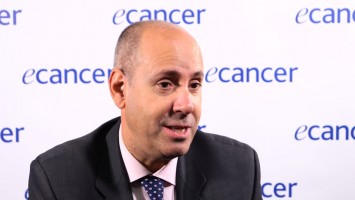15th Milan Breast Cancer Conference
Advances in treatment of triple negative breast cancer
Dr Clifford Hudis - Memorial Sloan-Kettering Cancer Center, New York, USA
I’m involved in a broad range of clinical trials and research related to all kinds of breast cancer. One of the areas of focus certainly is triple negative breast cancer and there’s a whole lot going on with that area of breast cancer right now. Several ways to think about it: first, we’ve always defined triple negative breast cancer simply by stating what it lacks, it lacks ER, PR and HER2, but that to me has always been frustrating because it’s, in the American context, like saying if you don’t live in California and you don’t live in Florida you must be a New Yorker, and this is not true, there are many things that you could be. So this heterogeneity, the sub-subsetting of triple negative breast cancer is really gaining traction right now and people are, of course, using things like gene expression profiling and other approaches to figure out if there are any meaningful subsets of triple negative breast cancer that could lend themselves to the development of targeted therapy. One in particular that we’ve been focussed on is the small percentage that actually have the male hormone receptor, the androgen receptor. By identifying those patients we have shown that some of them can actually be treated with the anti-androgen receptor drug, bicalutamide, an old drug that has been widely used for prostate cancer. Now, this is a very small subset, it’s a real orphan, but it does suggest that triple negative will lend itself to a little bit finer distinction and maybe we’ll be able to find more targeted therapies.
Another similar example, of course, are the PARP inhibitors which likely will be most effective in the subgroup who actually have a mutation in BRCA 1 or 2. But that’s not yet risen to the level of drug approval and so I think we still have a little bit of clinical trials work to do in that regard.
What do you see for the future of clinical trials in this area?
It is no secret that there are real challenges to the conduct of clinical trials right now. There are scientific challenges because we have an ever increasing number of targeted therapies and they are defined by ever smaller subgroups of patients. So catching those patients is tricky. At the same time whilst there is robust investment from the pharmaceutical industry in some ways right now it’s a little less than it used to be. And, of course, at least in the United States, we’re facing real budgetary constraints. Not only is the budget itself to the NIH and, by extension, to the NCI somewhat limited but we also have the acute problem of the sequestration which can only hurt. Let’s face it, even if it doesn’t do anything about clinical trials that are up and running today, the uncertainty about future investment means that investigators will not be able to expand programmes, hire personnel, build resources and we will pay the price for this for the current compromise in the years to come. Now, there is some reason for optimism. One of the exciting things that is happening right now is the increased development of real bio-informatics and very specifically the leveraging of these large databases that are being built in many parts of the world so that maybe we can start to learn from patients who are treated off clinical trials; in the US that’s 95-97% of all adults with cancer. The second thing is those kinds of electronic tools, CancerLinQ being the one that we’ve developed within ASCO, may be linked to clinical trials themselves so that clinicians would be able to use the tool to actually match patients more efficiently for studies. Pulling in genomic data as it’s increasingly available will similarly enrich this resource. We’ve seen other examples: in the UK just last week there was an announcement about a massive big data project to begin to explore the routine outcomes of patients for whom we know their clinical care and their outcomes as well as their genomics. So while there are certainly some storm clouds there also are some new reasons for optimism in the world of clinical trials.
What system do you see being implemented?
I think it’s a little tricky right now to imagine one system, I think there are many parallel systems that do different things. Certain kinds of drugs, let’s take an extreme, immune therapies that might not be so narrowly specific as other targeted therapies, they may be available in one system and then targeted therapeutics for very small populations could either be distributed if they’re safe or they might need to be centralised because the patients would have to travel to an experienced investigator. I think we’re going to see all these systems at once.








